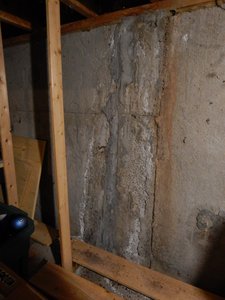Some foundation cracks allow water to leak into your basement while others do not. Still, most homeowners hate having cracks in their foundation, and/or a leaky basement; both of these situations will often motivate homeowners to undertake a foundation crack repair.
In this article we’ll explain how not to repair a foundation crack and why.
Common fears about foundation crack repairs
Today, many people know how quickly and inexpensive it is to have a foundation crack professionally repaired – by crack injection. Unfortunately, many people (both homeowners and contractors) still believe that a foundation has to be excavated to do a basement foundation crack repair.
Because excavation is costly and destructive, many homeowners dread the thought of having to deal with a waterproofing contractor for a basement crack repair. For this reason it is common for homeowners to undertake foundation crack repairs on their own, or to hire general contractors or handymen to either save money or avoid digging around their foundation. In most cases these savings end up costing homeowners more money in the long run; this is because improper leak repairs commonly have to be repaired a second time.
A common unprofessional and unreliable foundation crack repair
The most common way by which cracks are fixed unprofessionally is by applying a concrete patch (hydraulic cement) over the crack, as shown in the image below.
Patched foundation crack with staining from mineral
Repairing a foundation crack in this way is relatively simple and very cheap, making it a very attractive way to fix a crack in the foundation or to stop a basement leak. Unfortunately, this type of patch repair is actually bad for a foundation and doesn’t last. Let’s have a look at the picture below:
It is common for surface repairs to crack
The patch that was supposed to repair the crack or conceal it has cracked as well, rendering the repair useless. In the picture below you can see that the crack is leaking through the patch repair; the white staining is mineral that came through the foundation along with ground water.
Water trapped in a crack tends to seep over time
The reason why fixing a crack in this way is bad for your foundation is because the patch will cause ground water to be trapped within the crack. Since poured concrete is porous, the concrete will absorb the trapped water. When the concrete is saturated, the concrete begins to deteriorate as it begins to return to its original sandy state. Therefore, the foundation gets weaker and there is no way to reverse this type of deterioration.
The Top 5 Reasons to not fix cracks in this way
- Money spent fixing the crack by patching over it is usually wasted; in the end, you end up spending more money because you need to pay yet more money to have it properly repaired;
- By trapping water behind the patch within the foundation crack, the foundation weakens and cracks can widen as the trapped water freezes within it;
- If you finish your basement or close up the wall after repairing the crack in this way you may well end up having to open up the wall once again to repair it properly;
- If the patched crack leaks you may end up with mold, ruined drywall, warped laminate flooring, water damaged furniture, etc; and
- You simply cannot be confident that the repair will hold.
The good news is that foundation cracks can be repaired for a few hundred dollars, not thousands, by having them professionally injected.
